Aquariums with live plants are a lot of fun, but what if you want to take your underwater gardening to the next level? If you’re looking for cool aquascape ideas then you’ve come to the right place!
There’s more to aquascaping than just adding some plants to an existing fish tank. Did you know that an aquascaped tank might not even contain any fish? Read on to learn about the basics of aquascaping and find some planted tank ideas.
Introduction to Aquascape
Many folks get into aquarium keeping because they want beautiful community tanks filled with fish and other aquatic species. But for some aquarists, fish are practically an afterthought. When you get into aquascaping, your focus shifts from the animals to the plants and other visual elements in your tank.
What is Aquascaping?
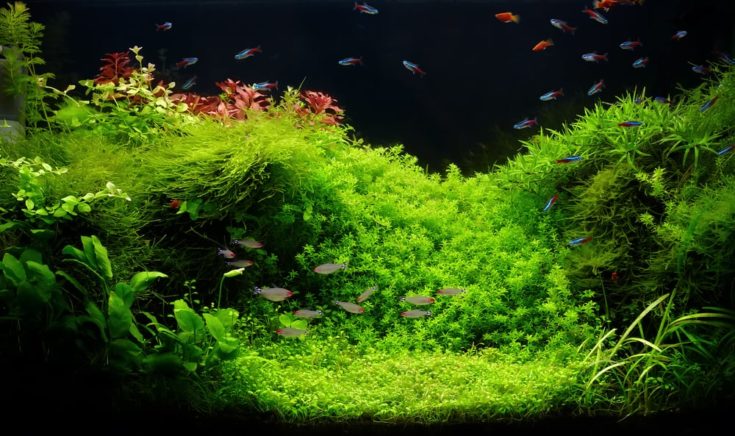
Aquascaping is the art of creating a living underwater garden in an aquarium. The goal of an aquascaped tank may vary depending on the size of the aquarium and style of aquascaping, but is usually aimed at creating a natural-appearing tranquil underwater environment.
An aquascaped tank starts with creating a design and layout using:
- Landscaping elements such as rocks and sticks referred to as hardscape.
- Live plants that are nurtured and pruned into specific shapes or designs.
- Substrates such as dirt, gravel or sand that help support rooting plant growth and add visual effects to your tank.
Most Common Styles of Aquascape
There are many styles of aquascaping, just as there are many styles of terrestrial gardening. You may find yourself drawn to a specific look or style, or you may prefer to use elements from several styles in your tank. The most popular styles of aquascaping include:
Iwagumi or Japanese Style
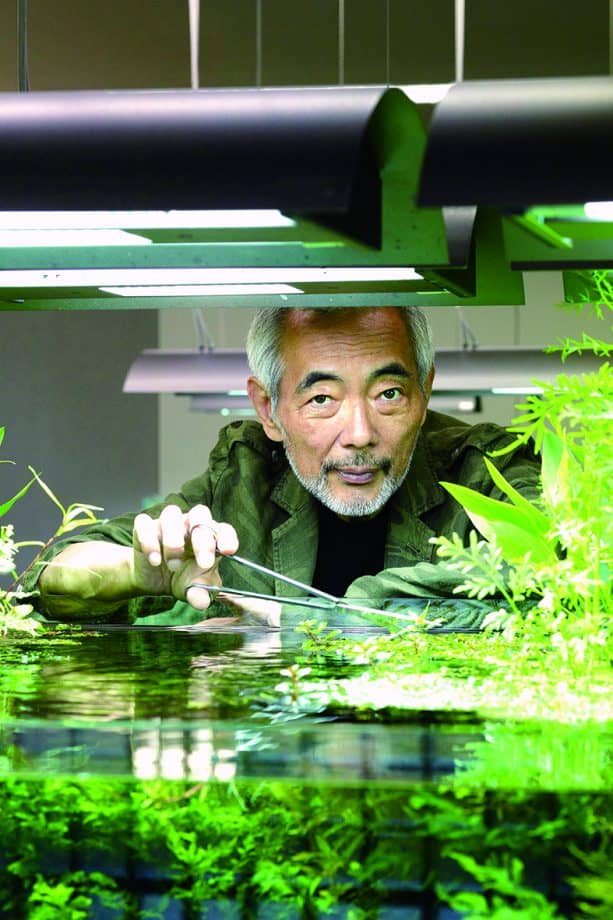
Takashi Amano, known as the Father of Modern Aquascape, brought this style to its current height of popularity. The Iwagumi aquascape utilizes odd-numbered rocks as the primary hardscape, with the largest “Father” rock dominating the tank. A few small-growing plants are chosen to balance and harmonize the effect.
It’s almost like recreating an underwater mountainside in your aquarium. Many Iwagumi-style tanks aim to recreate specific natural landscapes too. The plants are used as a backdrop to highlight the rock features or are used to mimic trees and bushes along a hilltop.
Scale and simplicity are critical to this style. The substrate should be very fine and almost disappear in the tank. You can use small freshwater shrimp or schooling fish like minnows or tetras to add to the sense of scale. This is an excellent option for nano tanks or even large 75-gallon aquascapes.
Dutch
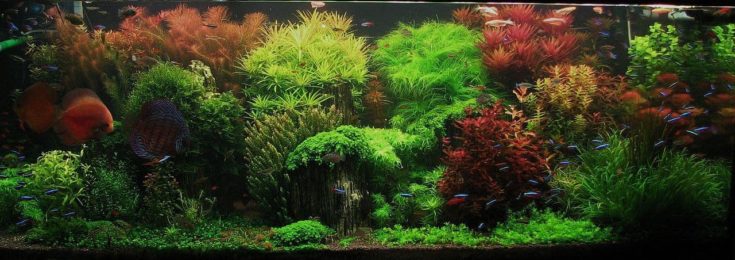
Dutch-style aquascaping relies on using a large variety of plants with many different colors and leaf shapes planted in rows or terraces within your tank. Oftentimes the substrate is completely hidden beneath a layer of low-growing small plants or mosses. Taller plants grow along the sides and back interspersed with other varieties.
Dutch aquascaping uses little or no hardscaping and relies on the plants and substrate to create visual layers within your tank. It may take several months or even longer before your tank looks the way you want as you prune and shape your plant’s growth.
If you’re interested in cultivating a tank in this style you’ll really need to invest in your equipment. To maintain such a densely planted tank you’ll need excellent lights, filters, and a carbon dioxide injection system. You can read more about equipment for aquascaped tanks below.
Natural
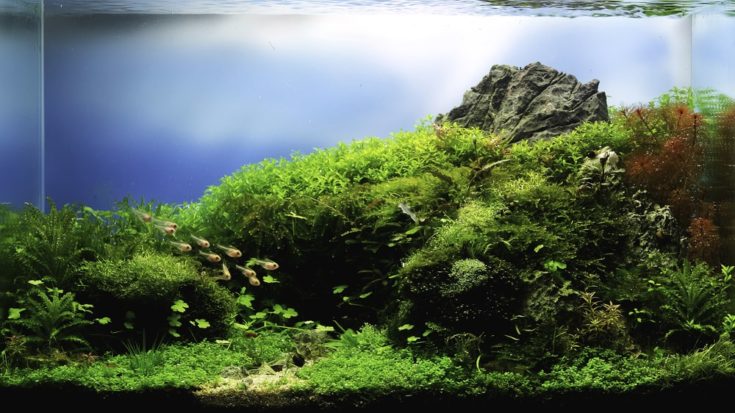
Naturally aquascaped tanks are all the rage these days and there’s no question that these tanks can have a dramatic impact. A natural aquascape mimics a habitat such as a riverbed or a lake bottom. The plants and hardscape are chosen and arranged to look as natural as possible.
The sky’s the limit when it comes to hardscape, as you can use rocks, sticks and multiple types of substrate to create the effect you desire. You might heap your substrate up in one corner and gradually level it across the tank, creating a gravel “waterfall or river” and use low growing plants to mimic the riverbanks.
Some natural freshwater aquarium aquascape design ideas include recreating terrestrial hillsides, mountaintops, and valleys, while advanced aquascapes might include a jungle or tropical island motif. Many natural aquascapes avoid using an aquarium backdrop so you can see into the tank in any direction.
17 Ideas for Aquascaping Your Tank
Here are some beautiful aquascaped tanks to give you some ideas of what you might accomplish in your aquarium with the right hardscape and design. You’ll notice that many aquascaped tanks use small fish or freshwater invertebrates to nibble algae, but don’t usually feature large fish or groups of fish.
1. Natural Lakebottom Aquascape How-To Video
This video gives a step-by-step demonstration on setting up a low-maintenance large natural aquascaped tank. You can see how the hardscape is used to create a rock wall around the plant substrate and then the wooden elements spring from that area. Gravel and sand are used around the hardscape to create the natural appearance of a lakebottom. The plants used in this aquascape are mostly those that grow easily on surfaces, such as Java Fern and other Microsorums.
2. Densely Planted Natural Aquascape
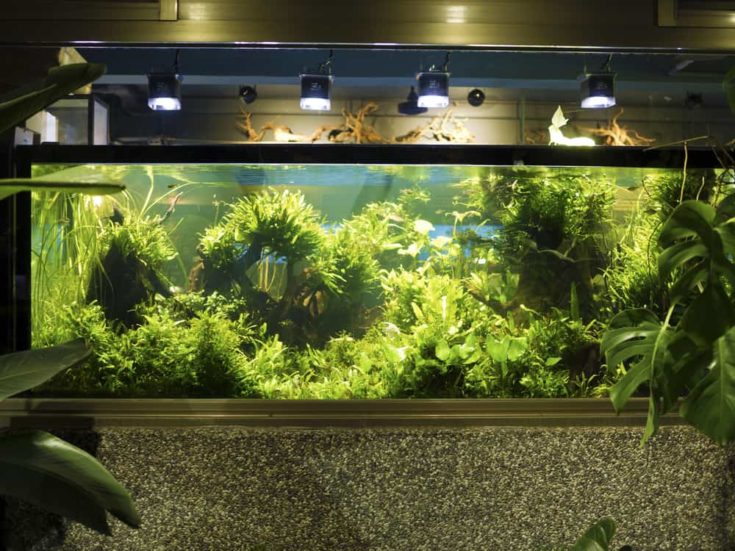
You can see how the substrate in this tank is completely obscured by the growing plants, and the growth continues up the hardscape and even out the top of the tank! You can tell that the substrate is piled into peaks and valleys to create layers in the tank. With the heavy plant growth on the branches you almost can’t see the hardscape in this mature tank.
3. Lakebottom Aquascape with Sandy Substrate
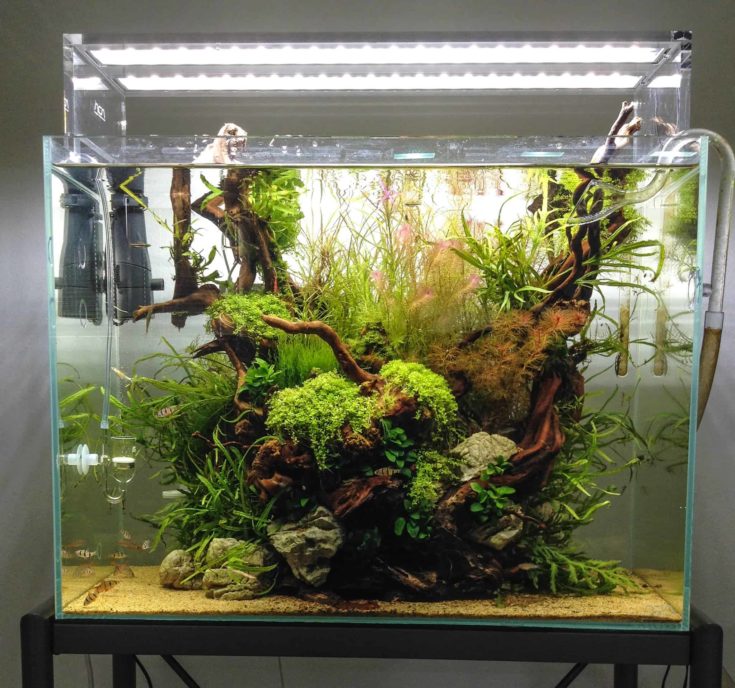
Similar to the tank in the video above, this tank uses a pile of rock and wooden hardscape to grow a wide variety of plants. You can see the Anubias and Java Ferns peeking out from some corners. It’s not as densely planted as some and so would be a good tank design for novice aquascapers and smaller aquariums.
4. Small Meadow Aquascape
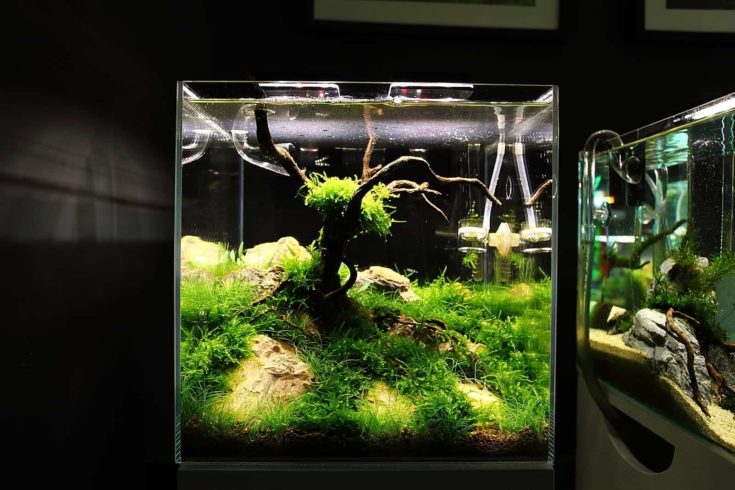
This is a good aquascape design for small tanks. The focal points are the branches arranged in the center that resemble an old tree, with a few small plants in the canopy to resemble tree leaves. The gravel is obscured by low-growing plants that give the impression of a grassy meadow. You can see a few rocks along the base of the tree that helps complete the image as well.
5. Natural Waterfall and River Aquascapes
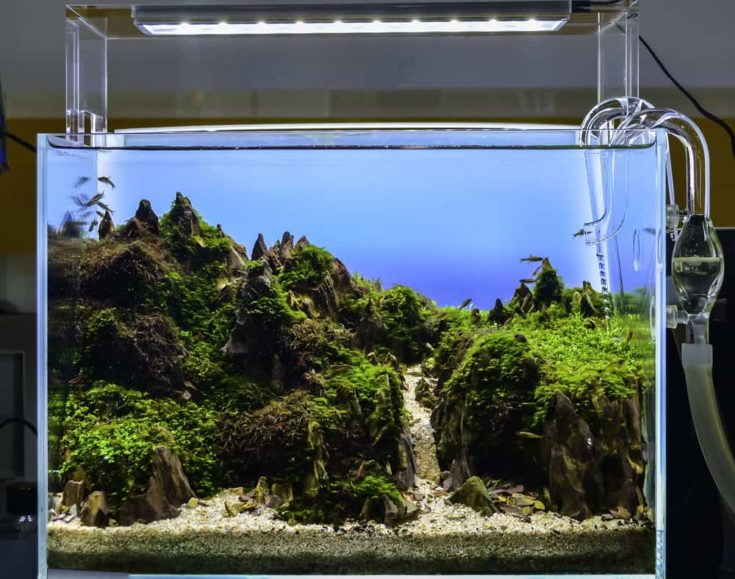
By layering different types of substrate in your tank and planting around the layers you can create the impression of waterfalls and flowing streams or rivers in your tank. You’ll notice that all of the low-growing plants are on the hardscape mountains, leaving the path of the gravel distinct and clear. This tank is almost Iwagumi in design, but not quite.
6. Natural Design for a 5-Gallon Aquascape
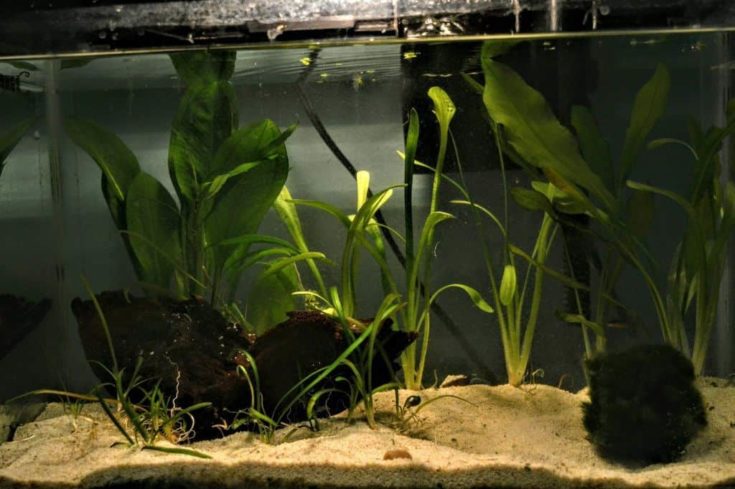
You don’t have to fill a tank with hardscaping and plants to aquascape! For a small or nano tank you can choose a few simple plants and a moss ball or two. By varying your substrate you can create streams or rivers in the bottom of your tank, or plant a few sticks and cover them with Java Moss to mimic trees! A single colorful plant or lily bulb would really stand out in this type of tank.
You might be curious how Java moss compares with another aquascaping plant like Christmas moss, you can check our detailed comparison here.
7. 10-Gallon Natural Aquascape
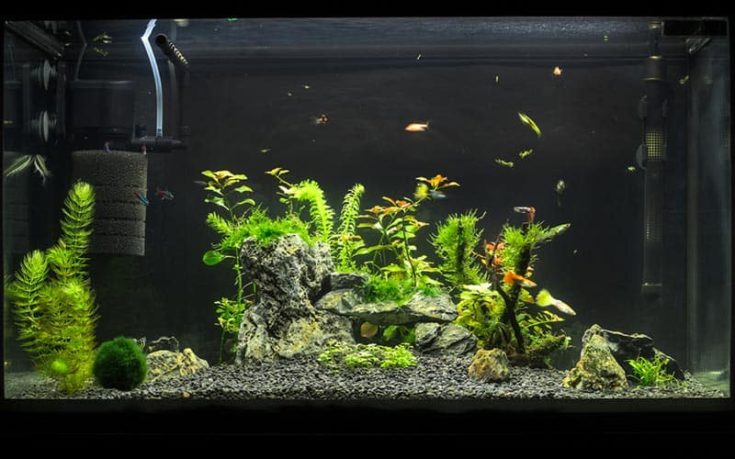
In small tanks, using a central element for hardscaping surrounded by a few taller plants like baby’s tears can have a dramatic impact. You don’t need to plant densely to aquascape your tank, and in smaller tanks, it might be easier to maintain a few varieties of easy-growing plants that don’t require CO2 injection or expensive lighting systems. A few plants along the back and several to each side balance the aquascape perfectly.
8. 75-Gallon Natural Aquascape with Low Lighting
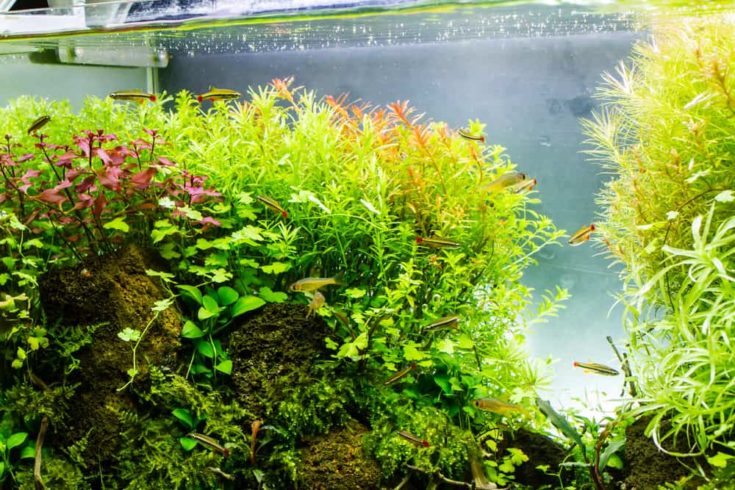
One option for a large tank is to go with a wide variety of easy-to-grow plants like Anacharis, Hornwort, and Java Moss. You can add more challenging plants to areas of your tank that get the most light or keep them towards the top of your tank. Then you can add layers of lower-light plants to the understory and under the hardscape. Once the plants on the bottom of your tank fill in you won’t even be able to see your substrate.
9. Amazon Natural Aquascape
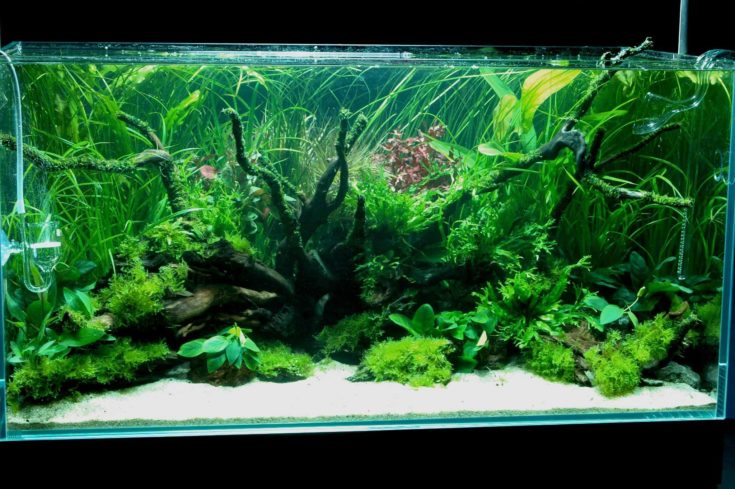
Another densely-planted natural tank, this one features a mix of wood and rock hardscaping with a large variety of plants growing on them. The sandy bottom is prominent in the front of the tank but the hardscaping hides the pockets of plant substrate in the back corners. Tall plants cover the back of the tank and frame the picture while your eye is drawn to the center of the wood pile in the tank.
10. Natural Island Aquascape
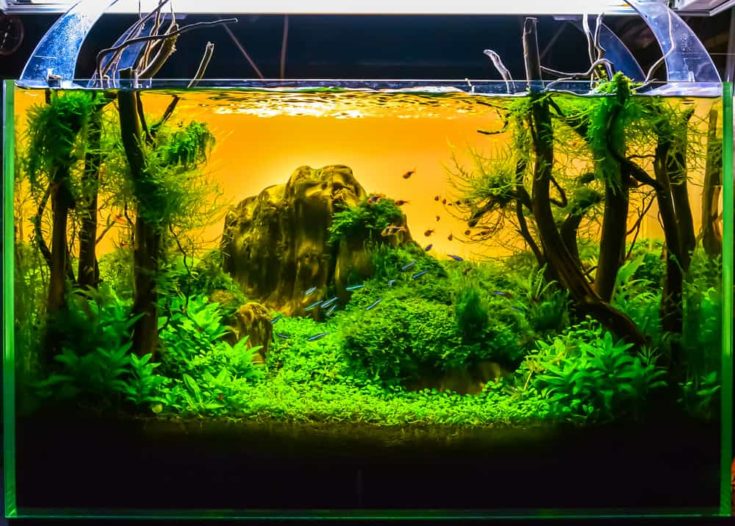
With the right backdrop, you can bring the sunset to your tank and create a tropical paradise! This tank is hardscaped to resemble a tropical island, with thick branches decorated with Java Fern to resemble trees in the foreground. Low-growing plants completely obscure the substrate and lead the eye to the rock feature in the back of the tank. The lack of plants in the rear of the tank really makes the sunset backdrop pop.
11. Iwagumi Aquascape How-To Video
You can see how much effort goes into creating the base for an Iwagumi-style aquascape. The substrate is added in layers, and nutrients are added to support the plant’s growth. The three rocks are carefully placed in the tank and arranged for a harmonious appearance. Then the plants are carefully added so they have room to grow and can fill in the gaps. These tanks look simple but are actually quite complex.
12. Iwagumi 5-Gallon or 10-Gallon Aquascape
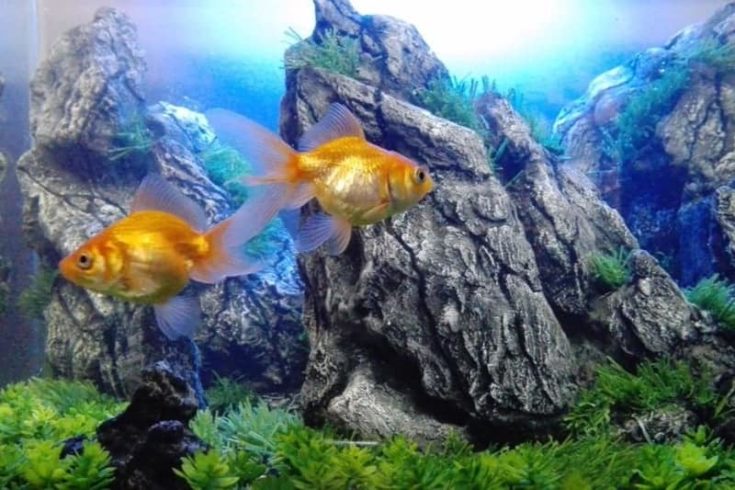
You don’t need a huge tank to practice aquascaping Iwagumi-style! This small set-up is suitable for goldfish or a betta and features three rock “cliffs” among the black sand substrate hidden beneath a layer of low-growing plants. You could recreate this type of tank in a 5 or 10-gallon set-up, and you wouldn’t need a CO2 injection system or expensive aquarium LED light to pull it off.
13. Simple Iwagumi Aquascape for Big Tanks
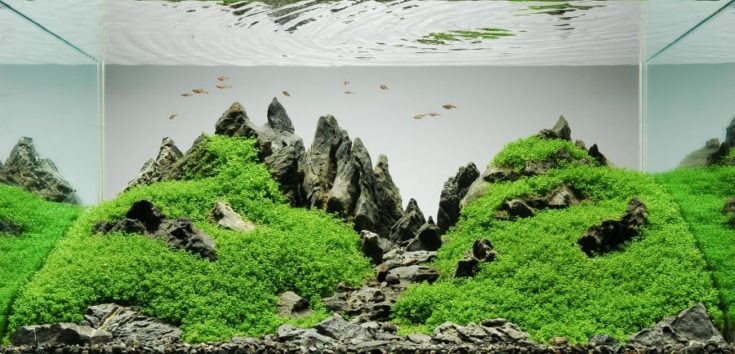
The Iwagumi style is suitable for tanks of all sizes, but is especially impressive when it’s done in a large tank. This tank features the classic rocky hardscape and only uses a single type of low-growing dwarf baby’s tears for the aquascape. The way the hardscape is layered in the tank obscures the substrate entirely and creates the impression of a dry wash or canyon between rock cliffs. The few schooling minnows give the impression of a flock of birds flying over the mountains.
14. Mountain Iwagumi Aquascape Diorama
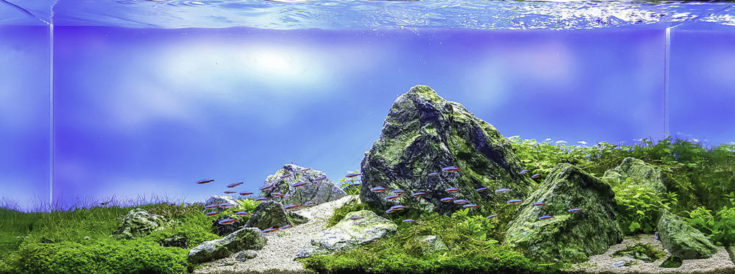
The creative use of an aquarium backdrop in this tank emphasizes the appearance of a mountain top with a prominent “Father” rock just off-center. The blue sky and clouds add a sense of height to the tank. With a few varieties of low-growing plants on the hardscape and planted on top of the substrate, the sandy “river” seems to flow down the mountainside.
15. Hilltop Iwagumi Aquascape
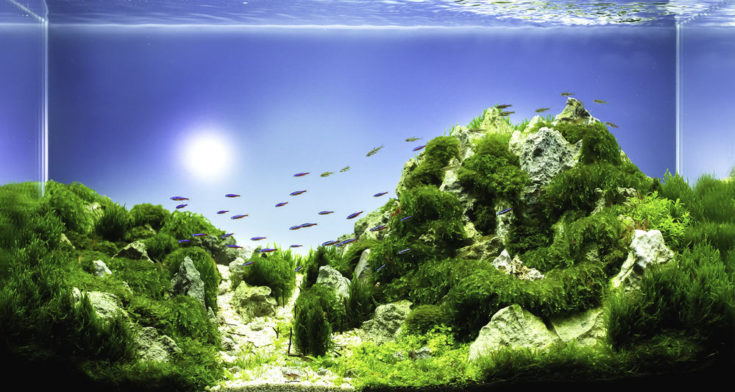
Another tank that uses the backdrop to give the feeling of a blue sky, this one features a cluster of rocky hardscapes hidden under pockets of low-growing plants. It also uses different gravel and sand substrates to mimic a canyon or valley bottom in the front of the tank. As your eye climbs up the hilltop you’ll see bits of the hardscape poke through, and a few schooling fish complete the look.
16. How-to Aquascape a Dutch Style Tank
This lovely video demonstrates in detail how to set-up and aquascape a tank using the Dutch style of planting in dense rows or tiers. You can see how the tweezers allow you to place plants in precisely the right place. The plants are spaced so that they will quickly grow together, and within a few weeks, this aquarium looks amazing! You’ll definitely want a CO2 system and high-quality lights for this type of aquascaping.
17. Large Dutch Aquascape
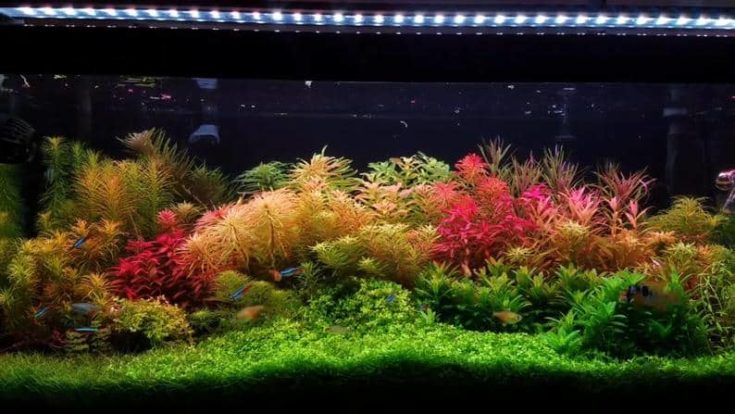
In this mature tank, you can see how the different colors and leaf shapes of the plants blend together to create a uniform backdrop of plant life throughout the tank. The substrate is completely hidden under low-growing plants, and the taller plants on the sides and back keep drawing the eye towards the center of the tank. You can see the LED strip light that supports these beautiful plants and the pop of color offered by the schooling tetras in the tank.
Get These Plants HereYou Might Also Like: Walstad Method
Conclusion
I hope this article has given you some aquarium landscape ideas for your aquascaped tank! There are many backdrops and aquarium plant designs you can follow to create a specific natural look, or you can go crazy and introduce other interesting elements into your tank.
You could tuck a castle decoration on a mountaintop or crash a UFO into your substrate for fun. The key to aquascaping is to use your plants to highlight the hardscape in your tank and to prune them for the best growth and appearance.
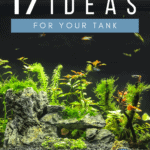
Nice work
Beautiful article! Great starting place for us amateur aquarists to choose an aquascape design. Thank you!